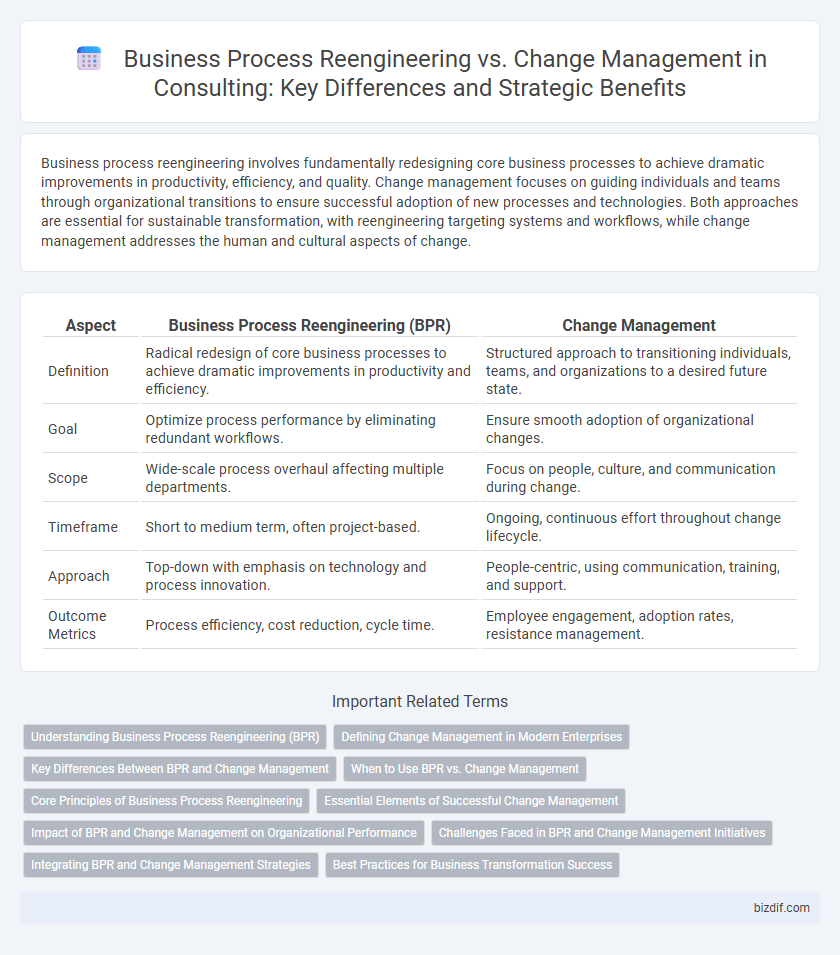Business process reengineering involves fundamentally redesigning core business processes to achieve dramatic improvements in productivity, efficiency, and quality. Change management focuses on guiding individuals and teams through organizational transitions to ensure successful adoption of new processes and technologies. Both approaches are essential for sustainable transformation, with reengineering targeting systems and workflows, while change management addresses the human and cultural aspects of change.
Table of Comparison
| Aspect | Business Process Reengineering (BPR) | Change Management |
|---|---|---|
| Definition | Radical redesign of core business processes to achieve dramatic improvements in productivity and efficiency. | Structured approach to transitioning individuals, teams, and organizations to a desired future state. |
| Goal | Optimize process performance by eliminating redundant workflows. | Ensure smooth adoption of organizational changes. |
| Scope | Wide-scale process overhaul affecting multiple departments. | Focus on people, culture, and communication during change. |
| Timeframe | Short to medium term, often project-based. | Ongoing, continuous effort throughout change lifecycle. |
| Approach | Top-down with emphasis on technology and process innovation. | People-centric, using communication, training, and support. |
| Outcome Metrics | Process efficiency, cost reduction, cycle time. | Employee engagement, adoption rates, resistance management. |
Understanding Business Process Reengineering (BPR)
Business Process Reengineering (BPR) involves the fundamental redesign of core business processes to achieve significant improvements in productivity, cycle times, and quality. It targets radical changes by analyzing workflows and identifying inefficiencies to streamline operations, often leveraging technology to enable innovation. BPR differs from change management by focusing on process transformation rather than managing the human and organizational aspects of change.
Defining Change Management in Modern Enterprises
Defining change management in modern enterprises involves systematically guiding organizational transitions to enhance adaptability and performance. It emphasizes aligning people, processes, and technology through structured communication, training, and stakeholder engagement. Unlike business process reengineering, which focuses on radical process redesign, change management prioritizes minimizing resistance and fostering sustainable adoption of change initiatives.
Key Differences Between BPR and Change Management
Business Process Reengineering (BPR) involves radical redesign of core business processes to achieve dramatic improvements in productivity, efficiency, and quality, while Change Management focuses on managing the people side of change to ensure successful adoption and minimize resistance. BPR is project-oriented with a focus on process innovation and technology integration, whereas Change Management emphasizes communication, training, and stakeholder engagement throughout the transition. Key differentiators include BPR's emphasis on process overhaul versus Change Management's goal of facilitating behavioral and cultural adaptation within an organization.
When to Use BPR vs. Change Management
Business process reengineering (BPR) is ideal for organizations seeking radical transformation through the complete redesign of core processes to achieve significant performance improvements. Change management is more effective when guiding employees through incremental adjustments or organizational changes that require alignment, adoption, and minimal disruption. Use BPR in scenarios demanding breakthrough innovation or crisis recovery, while change management suits continuous improvement and cultural shifts.
Core Principles of Business Process Reengineering
Business Process Reengineering (BPR) centers on radically redesigning core business processes to achieve dramatic improvements in critical performance measures such as cost, quality, service, and speed. Core principles of BPR include focusing on processes rather than tasks, challenging existing assumptions, and utilizing information technology to enable new process designs. Unlike Change Management, which emphasizes managing people and organizational adjustments, BPR targets foundational process transformation for breakthrough results.
Essential Elements of Successful Change Management
Successful change management hinges on clear communication, strong leadership commitment, and active employee involvement to ensure smooth transitions during business process reengineering. Establishing measurable goals, providing adequate training, and fostering a culture of adaptability are critical elements that minimize resistance and enhance stakeholder engagement. Continuous monitoring and feedback loops enable organizations to adjust strategies and sustain long-term improvements effectively.
Impact of BPR and Change Management on Organizational Performance
Business process reengineering (BPR) drives radical changes by fundamentally redesigning workflows, leading to significant improvements in efficiency, cost reduction, and customer satisfaction. Change management focuses on guiding employees through the transition, enhancing adoption, minimizing resistance, and sustaining performance gains. Combining BPR and effective change management results in optimized organizational performance, balancing innovation with employee engagement and operational continuity.
Challenges Faced in BPR and Change Management Initiatives
Business process reengineering (BPR) initiatives often face challenges such as employee resistance, high implementation costs, and disruption of existing workflows, which can hinder the redesign of core processes. Change management efforts struggle with communication barriers, misalignment of stakeholder expectations, and inadequate training, impacting the successful adoption of new systems and behaviors. Both disciplines require strong leadership commitment and comprehensive stakeholder engagement to overcome these obstacles and achieve sustainable organizational transformation.
Integrating BPR and Change Management Strategies
Integrating Business Process Reengineering (BPR) and Change Management strategies enhances organizational transformation by aligning process redesign with employee adoption and cultural shifts. BPR focuses on fundamentally rethinking and radically redesigning business processes to achieve dramatic improvements, while Change Management ensures stakeholder engagement, communication, and training to support the transition. Combining these approaches reduces resistance, accelerates implementation, and maximizes sustainable performance improvements in consultancy projects.
Best Practices for Business Transformation Success
Business process reengineering (BPR) emphasizes radical redesign of core business processes to achieve dramatic improvements in productivity and efficiency, while change management focuses on managing the human and organizational aspects to ensure smooth adoption and minimize resistance. Best practices for business transformation success integrate clear communication, stakeholder engagement, and continuous performance measurement to align reengineering efforts with organizational culture and strategic goals. Leveraging data-driven insights and adaptive leadership enhances the synergy between BPR initiatives and change management for sustainable transformation outcomes.
Business process reengineering vs Change management Infographic

 bizdif.com
bizdif.com